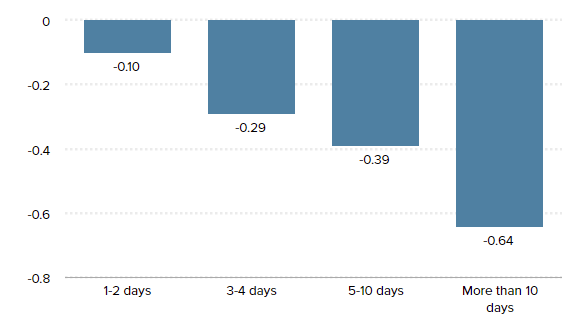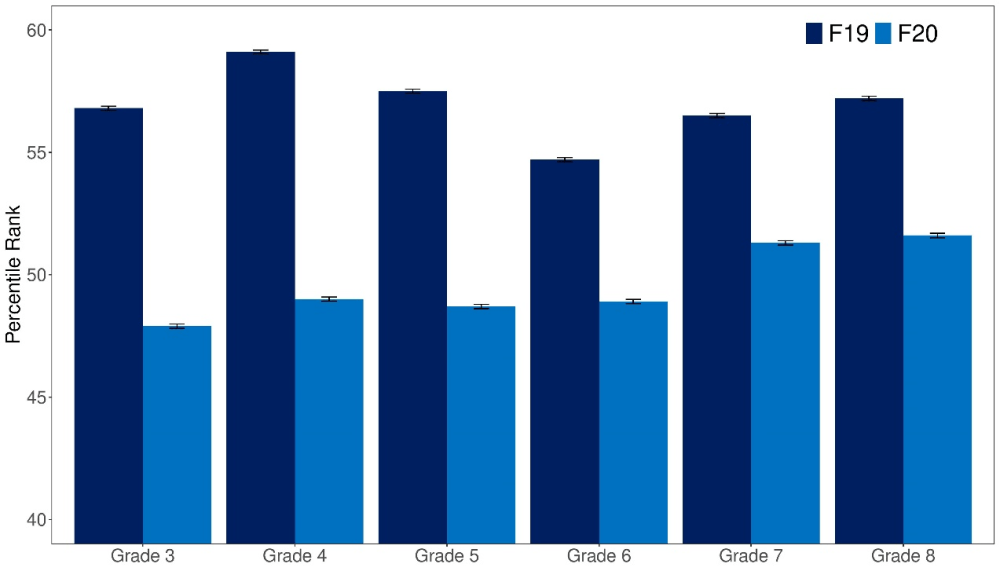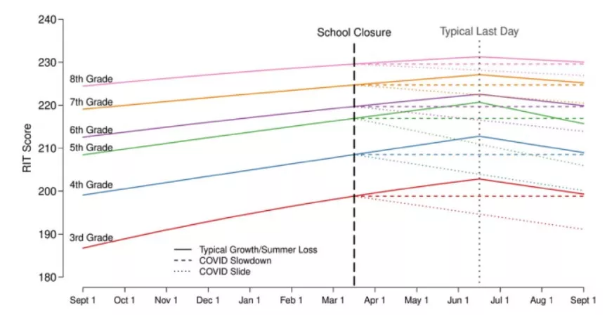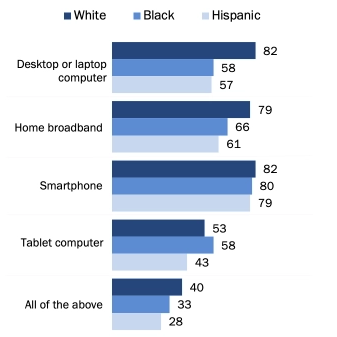Executive Summary
The COVID-19 pandemic has negatively affected students’ performance in Miami Dade-County due to restrictions on in-person learning. Particularly, K-12 schools in the county have reported widening achievement gaps and declining performance levels among students. This policy analysis paper outlines four possible alternatives that Miami Dade-County education authorities could adopt to make sure that K-12 students are not left behind academically due to the ravaging effects of the COVID-19 pandemic. First, they should develop targeted outreach programs for students who are struggling to cope with the pandemic, based on the results of educational progress monitoring and review assessment reports. Secondly, authorities should connect curriculum development processes to digital learning experiences. The goal is to create better synchrony and alignment between the curriculum development process and students’ digital learning experiences. Thirdly, policymakers need to train teachers regarding the latest online tools, trends and developments affecting K-12 education through seminars and training programs. Fourth, a “do nothing option” is proposed, which means that authorities can refrain from coming up with new strategies to mitigate the effects of the health crisis on learning outcomes and allow the situation to “play out” as it may. This proposal is hinged on the fact that the COVID-19 pandemic is still an unfolding event and the effects of linked variables on learning outcomes cannot be holistically accounted for. The four policy alternatives outlined above are expected to be evaluated based on their economic, efficiency, equity, administrative feasibilities and effectiveness. Subject to this evaluative framework, developing targeted outreach programs is outlined as the chosen policy alternative for this study. It is the best strategy to follow because it comes at a low cost to both school-level and district-level administrators and allows them to create focused interventions for addressing specific learning gaps. Broadly, based on the insights highlighted above, key sections of this paper review existing policy programs, analyze the framework for evaluating their effectiveness, and outlines policy alternatives that could address some of the implementation gaps associated with the COVD-19 pandemic and its impact on the educational outcomes for K-12 learners in Miami-Dade County.
Problem Statement
The effects of the COVID-19 pandemic on the Miami-Dade County education sector have created concerns that K12 students are lagging academically due to restrictions on in-person learning, which are associated with negative learning outcomes. Relative to this assertion, Rado (2020) says, “School closure disrupts the delivery of in-person instruction and critical services to children and families, which has negative individual and societal ramifications” (p. 1). Additionally, increased stress levels among teachers, a rise in school dropout rates, and heightened challenges in validating and measuring learning outcomes are associated with long periods of school closures and negative educational outcomes (UNESCO, 2021). These findings reveal that school absenteeism has an impact on the psychosocial wellbeing of both students and teachers alike (Garcia & Weiss, 2020). Therefore, there is a common understanding among education stakeholders that prolonged school closures negatively affect students’ achievement levels. To support these findings, figure 1.1 below shows that worsening grade scores are associated with school absenteeism. The findings were obtained from a mathematics-based assessment for eighth graders in the US.

The negative effects of the COVID-19 health crisis on student achievement levels has also been associated with the loss of student achievement outcomes. For example, researchers estimate that the pandemic has led to a loss of about 30% of student achievement progress in the past year (Kuhfeld, et al., 2020). Moreover, the percentage of students who have made relative gains in their academic record declined from 79% in 2019 to 57% in 2020 (Hooker, 2020). These findings mean that the health crisis has forced students to lose 30% of their learning gains, compared to the pre-COVID levels.
Statistics also show that the effects of school closures on academic performance have demonstrated peculiar trends with stronger achievement gaps observed in certain subject areas, such as mathematics and sciences, while languages and humanities are relatively lowly affected (Garcia & Weiss, 2020). Relative to these findings, disparities in learning outcomes have also been observed across different grade levels, such as across 3-8 for mathematics as described in figure 1.2 below.

Additionally, according to figure 1.2 above, the achievement performance levels for mathematics students was between five and ten percentages lower than the pre-COVID year 2019. Indeed, since the re-opening of schools in late August 2020, students have recovered from lost school time with only 50% of typical learning gains observed, relative to a normal school year (Kuhfeld, et al., 2020). Figure 1.3 below further shows how the COVID-19 pandemic has created performance gaps in mathematics, with statistics showing that students have been affected to the extent of having to repeat certain grade levels to be at par with their counterparts.

This drop in performance means that achievement levels in certain subject areas are more profound than others are. Relative to this finding, the Northwest Evaluation Association conducted a study in Miami Dade County by comparing the academic achievement gaps before and during the COVID-19 pandemic and found that most students who are between their 3rd and 5th grades lost 30% of their literacy skills during the pandemic period (Kuhfeld, et al., 2020). Again, mathematics was singled out as having the biggest drop with a 50% reduction in achievement outcomes (Kuhfeld, et al., 2020). Several reasons have been voiced to explain why there has been a drop in performance across several subject areas in the wake of the COVID-19 pandemic. For example, a Harvard-sanctioned survey noted that the drop in the performance of these subject areas was because most families paid little attention to mathematics and sciences in the first place (Hooker, 2020). Therefore, students are offered little support from parents in these subject areas.
Reports also indicate that the current global health crisis could significantly widen achievement gaps among different cohorts of students in Miami Dade County. Particularly, discussions about race have emerged from these developments because those from minority populations, such as African-Americans and Hispanics, are disproportionately affected by the COVID-19 pandemic (Florida Department of Education, 2020a). Racial inequality is an issue that has been previously discussed among teachers, policymakers and community members with diverse opinions characterizing the debate. For example, in a town hall discussion involving students from Dade County, it was observed that the default setting in the education system has always been associated with “whiteness” (Cetoute, 2020). At the same time, there have been limited discussions about how other races have played a role in contributing to the country’s social, political and economic life, thereby creating a success narrative centered on racial superiority (Cetoute, 2020). It has permeated in the country’s education system and created classes of insensitive new generations of students who are unaware of the social and historical burden of racism that has remained alive in America’s pubic life for centuries and affected the performance of some students.
The above findings suggest that most students are unware of the plight of their peers and are likely to propagate the same thinking in the new learning environment. For example, Perrin and Turner (2019) describes this problem by explaining that African-American and Hispanic populations in the US have low levels of internet access, which undermines their ability to cope with the use of digital learning tools in a new learning environment. In line with this observation, statistics show that about 82% of white students report having a laptop or computer at home, compared to only 58% and 57% of the African-American and Hispanic populations, respectively (Perrin & Turner, 2019). These disparities have further been highlighted through variations in broadband connection with the same patterns observed across different races. For example, 79% of white households reported having a broadband internet connection, while only 66% of the African-American population and 61% of Hispanic households had the same type of connection (Perrin & Turner, 2019). Figure 1.4 below highlights the depth of these disparities.

If left unchecked, education inequalities brought by the COVD-19 pandemic could exacerbate because some students may struggle to adjust to the new learning environment, while others have an easier time doing so. The link between these social struggles and income inequality, among other socioeconomic issues that have a direct impact on how fast students adapt to a new learning environment, create the potential for more inequality to be institutionalized in the education system. For example, online learning has been proposed as a solution to mitigate the effects of the COVID-19 pandemic on the Dade County education system. However, adopting such a strategy is based on several assumptions, such as students having an equal access to digital learning tools, a safe and productive learning environment at home, and sufficient parental support, just to mention a few.
As alluded in this document, students come from diverse backgrounds and may not have the same opportunities to adopt online learning. To demonstrate this problem, Camera (2021) gives an example of how students from Northshore school district, which is privileged, almost all white, has households incomes of more than $100,000 per annum, and broadband internet would have an easier time adapting to the new learning environment compared to students lacking the same type of resources and support (Camera, 2021). Therefore, the complexities brought by the COVID-19 pandemic may exacerbate education inequalities that exist today if some of the proposals to address the crisis are adopted as they are. Moreover, health fears among students, workers, and education staff may also significantly impede the quality of learning due to poor motivation and adaptability to the new learning environment (Florida Health, 2020). This situation may cause prolonged uncertainty in the learning environment, thereby worsening the quality of education for K-12 learners (Brown, 2020).
This policy paper outlines recommendations that the State of Florida could do to make sure That K-12 Students are not left behind academically due to the effects of the ravaging pandemic on the education sector. Failure to address these concerns could lead to learning losses and an increase in inequality within the education system. Consequently, there is a need to implement learning recovery programs and prepare for future shocks to the education system to avert the disruptions that have been witnessed from the current pandemic.
Review of Existing Policy Programs
The overall goal of evaluation is to assess whether policies are achieving their intended goals, or not. This definition is consistent with the recommendations of Kraft and Furlong (2017), which suggests that policies are not made in a vacuum because there are significant social, political, and economic ramifications underlying their formation and implementation. Florida District’s school intervention plan has laid out specific policy plans to bridge achievement gaps caused by the COVID-19 pandemic. They are outlined below.
Providing Additional Instructional Time
Under emergency order DOE ORDER NO. 2020-E0-07, K-12 schools are supposed to provide additional instructional time to students who are posting poor performance through supplementary summer and weekly programs (Florida Department of Education, 2020c). The goal is to compensate for lost instructional time and they mirror similar plans adopted by K-12 schools in Southern Florida (Goodhue, 2021; Florida Department of Education, 2020b). For example, Monroe County School District has adopted similar policies by providing additional instructional time to students who are having learning difficulties (Goodhue, 2021). These remedial lessons have helped to bridge the gap in learning outcomes for different cadres of students.
Virtual Learning
Since the onset of the pandemic, authorities and education stakeholders in Florida have advocated for the adoption of virtual learning methods as a supplementary education tool to carry out learning activities. Before, the pandemic, virtual learning only accounted for a negligible portion of K-12 educational activities because most education services were conducted in-person, with the exception of online public schools. While virtual learning continues to gain traction in the education system, concerns about inequalities and limited access to digital learning resources have forced stakeholders to adopt a mixed approach to education reopening. Consequently, there is a trend to merge both in-person and virtual learning procedures to aid the reopening of schools. Therefore, students are back in class either full time in-person learning or through virtual classroom setups.
CDC-Aligned Programs
In-person learning procedures at K-12 schools have been formulated based on the guidelines provided by the Center for Disease Control (CDC). They have been developed based on the need for educational institutions to practice social distancing, sanitization, and wearing of masks as preconditions for the reopening of schools. However, some sections of education stakeholders have opposed such plans and sued state and county authorities in Miami for approving them in the first place due to concerns about new infections (Florida Health, 2020). For example, teachers’ unions have expressed concerns about the safety of the teaching staff if in-person learning is allowed to resume. Pasco County Teachers Union is among such bodies that have filed lawsuits to challenge the decision by their local authorities to allow in-person learning (Solocheck, 2020). Similar debates have characterized decisions by Broward and Miami-Dade Countries to reopen schools (Rado 2020). The failure of education officials to agree on the modalities for opening these learning institutions has led to the neglect of performance achievement gaps created by the pandemic. Consequently, there have been no policies developed to address the issue.
Evaluative Criteria
Most policy decisions are evaluated based on a pre-determined set of criteria that are specific to the learning environment. For purposes of this report, the policy evaluation process is designed to appeal to K-12 students in Miami-Dade County. The following considerations should be considered for analysis.
- Cost of the Program: Policy decisions aimed at closing learning gaps in Florida need to be assessed based on their economic feasibility. Two impact categories could be used to undertake the evaluation: cost to the school district and to parents. This dual framework of review would provide a holistic understanding of the economic viability of the proposed plans, including costs attributed to the schools for adopting new recommendations.
- Equity: Equity refers to the ability of an education system to be fair and impartial in the provision of education services to different classes of students. It is primarily concerned with evaluating policies based on whether all students get an equal opportunity for success, or not (WATERFORD, 2019). In this paper, the potential of the COVD-19 pandemic to exacerbate racial, grade-level, subject-level and socioeconomic inequalities among student populations have been highlighted. They are associated with four impact categories: inter-racial, socioeconomic, subject-level and grade-level inequalities
- Administrative Feasibility: K-12 schools should have sufficient administrative capacity to implement proposed programs. This capability needs to be proven at the school administrative level and within the schools. They outline the two impact categories of assessment that should be formulated for assessing the administrative feasibility of the proposed plans, while, at the same time, being paralleled with each other to create synchrony in the achievement of education performance goals.
- Effectiveness: The effectiveness of a policy or program refers to how well the proposed guidelines achieve their intended goals. For purposes of measuring the effectiveness of policy guidelines to address the impact of the COVID-19 pandemic on the performance of K-12 schools, three impact categories could be used for assessment: procedural, substantive and transactive effectiveness. Procedural effectiveness translates to the ability of policies to meet their accepted principles and provisions, while substantive effectiveness refers to the ability of the same policies to achieve their established goals (Pradhan et al., 2017). Additionally, transactive effectiveness can be assessed by evaluating how well procedural meet substantive goals.
Policy Alternatives
Education stakeholders in Miami Dade-County could adopt four policy alternatives to address academic achievement gaps in K-12 schools. They are outlined below.
- Develop Targeted Outreach Programs: Current policy proposals have been focused on providing additional instructional time to different student groups. Based on the need for focused learning, they should consider developing targeted outreach programs for special cohorts of students, subject to the outcomes of progress monitoring and review assessment results. Outreach interventions may be categorized according to students’ grade levels, racial and ethnic diversity, subject-level differences, and learning modalities, as proposed by the Florida Department of Education (2020b). The school administrators should oversee the outreach programs because they will be integrated with school educational curricula. In other words, schools will be encouraged to develop their programs, while district educational authorities provide technical assistance and funding. The outreach programs will be implemented as in-class demonstrations and online tutorials for both in-person and virtual learning sessions.
- Connecting Curriculum Development to Digital Learning Experiences: School authorities should consider redesigning learning curriculum to reflect digital learning experiences. This strategy should be executed at the school administration level through project-based learning to have a deeper understanding of students’ learning experiences during the virtual learning sessions and redesign the curriculum development program to reflect the outcome. Relating the academic content to the students’ online learning experiences would encourage them to find relevance in their educational programs, thereby fostering creative thinking, which is critical for K-12 learners’ cognitive development.
- Staff Training: To some degree, teachers are already equipped with the technical skills needed to undertake online learning. However, as Wotto (2020) says, no matter the level of technical skills an employee possesses, there is still some room for improvement. This is why staff training is proposed as an alternative policy intervention to support online learning. School administrators should oversee the program and the plan may be implemented through seminars, technical skills training programs and include training regarding content writing, data analysis among others digital learning activities.
- Do Nothing: School authorities can refrain from coming up with new strategies to mitigate the effects of the COVID-19 health crisis by allowing current programs to continue without making significant changes to them. This proposal is hinged on the fact that the COVID-19 pandemic is still an unfolding event, thereby making it difficult to account for all variables that could affect learning outcomes. Therefore, in this policy alternative, current programs will continue unabated.
Evaluation and Recommendations
Evaluation
Table 5.1 Policy Evaluation Criteria
Recommendation
Based on the policy criteria described in table 5.1 above, developing targeted outreach programs is the best option to pursue in this analysis because it has a score of 33 while other policy alternatives have scores of 15, 24 and 27. The most important feature about developing targeted outreach programs is its high level of effectiveness because it provides focused interventions for students who are lagging behind academically and those who may be adversely affected by pre-existing inequities in education. Furthermore, it provides a basis for comparing the performance of students who are in the general and targeted outreach programs.
Proposed Data Collection Activities
Based on the policy alternatives outlined above, future studies should focus on collecting primary data through surveys and interviews to assess the impact of the policy alternatives in addressing the academic achievement gaps created by the COVID-19 pandemic. These primary data collection techniques should be designed to collect information from school principals, teachers, and administrators. The surveys should be administered virtually to teachers from different K-12 schools in Miami-Dade County to give a status report on the effectiveness of proposed policies. Academic data should also be collected as secondary research materials that would help to explain the findings obtained from the surveys and interviews. These Supplementary pieces of evidence could be obtained from education reports, government publications, books, and journals. Both primary and secondary sets of data are critical in understanding the effectiveness of existing policies because the surveys and interviews would provide subjective data, while the published information would provide statistical support.
References
Brown, D. J. (2020). Nearly 3,000 more COVID-19 cases related to FL schools: At least 100 infections in each of eight counties. Web.
Camera, L. (2021). Lessons learned from a year of closed schools.
Cetoute, D. (2020). Our stories, our narratives matter. Black Town Hall talks race equity in local education. Web.
Florida Department of Education. (2020a). Reopening Florida’s Schools and the CARES Act.
Florida Department of Education. (2020b). Spring 2021 education plan and assurances: Miami-Dade County public schools.
Florida Department of Education. (2020c). Emergency order.
Florida Health. (2020). Guidelines and reports: Responding to COVID-19 in schools.
Garcia, E., & Weiss, E. (2020). COVID-19 and student performance, equity, and U.S. education policy.
Goodhue, D. (2021). South Florida schools say no changes — they are adhering to CDC reopening guidelines. Web.
Hooker, C. (2020). Closing the achievement gap: The road from recovery to restart.
Kraft, M., & Furlong, S. (2017). Public policy: politics, analysis, and alternatives (6th ed.). London: CQ Press.
Kuhfeld, A. et al. (2020) How is COVID-19 affecting student learning? Web.
Perrin, A., & Turner, E. (2019). Smartphones help blacks, Hispanics bridge some – but not all – digital gaps with whites.
Pradhan, N.S. et al. (2017). Analyzing the effectiveness of policy implementation at the local level: A case study of management of the 2009–2010 drought in Yunnan Province, China. International Journal of Disaster Risk Science, 8(1), 64-77.
Rado D. (2020). Amid a public health crisis called COVID-19, our schoolchildren will be left behind. Web.
Solocheck, J. (2020). In Florida school reopening lawsuit, sides find little agreement.
UNESCO. (2021). Adverse consequences of school closures.
WATERFORD. (2019). Why understanding equity vs equality in school can help you create an inclusive classroom.
Wotto, M. (2020). The future high education distance learning in Canada, the United States, and France: Insights from before COVID-19 secondary data analysis. Journal of Educational Technology Systems, 49(2), 262-281.